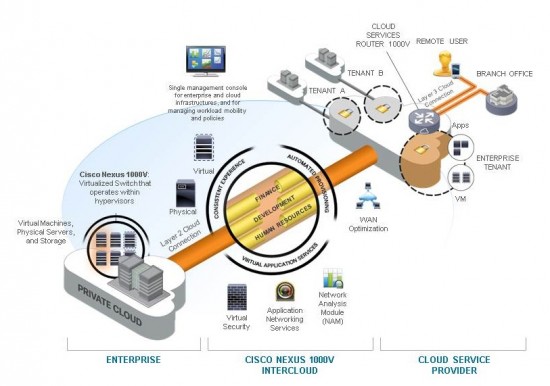































In a recent post, I previewed some new hybrid cloud market research from Forrester that spoke to the business drivers and technical hurdles to cloud integration, and Shashi Kiran has recently posted about lowering the barriers to hybrid cloud adoption. Today, as part of a larger cloud technology launch, Cisco is announcing a new hybrid cloud solution, Nexus 1000V InterCloud.
One of the fundamental capabilities for the world of many clouds is the ability to link various cloud environments into a single extended fabric with consistent capabilities, operations and management. While previous Unified Fabric innovation has focused on physical/virtual consistency of the DC fabric, this announcement brings that consistency to the cloud. This new technology from Cisco extends the existing networking capabilities, L4-7 services and manageability of your enterprise into public and provider clouds to create a single consistent, reliable, predictable environment for all your physical, virtual and cloud workloads. This secure and seamless degree of integration to the hybrid cloud frees you to run and move applications where it makes the most sense, on-demand, without compromise.
[Note: Join us for a Live Announcement Webcast February 5:Register Here]

Enterprises are increasingly moving to hybrid clouds to gain the benefits of public clouds -agility, on-demand provisioning, pay-as-you-go capability, and elastic scalability -along with the benefits of private clouds. Private clouds have some advantages, allowing enterprises to design and customize their infrastructure and control security. However, private clouds are usually less agile than a public cloud and may be limited in scale to meet peak capacity demands.
Cisco Nexus 1000V InterCloud is designed to provide the control and agility of a hybrid cloud to give you the best of both worlds while reducing costs and improving efficiency. It is a software solution deployed as virtual machines in the enterprise data center and public cloud, with three major components as seen in the above diagram:
The design of the Nexus 1000V InterCloud differentiates itself from other hybrid cloud solutions in a number of significant ways:
In Part 2, we will discuss more about the management of the hybrid cloud environment across both the on-premises resources and at the cloud service provider.
Related: New Independent Research Study on Hybrid Cloud Business Trends and Technical Challenges
As a special added bonus, watch our introductory video of the Nexus 1000V InterCloud solution:
https://www.youtube.com/watch?v=KT8XHNX1NSg
 Etiquetas calientes:
Hybrid Cloud
InterCloud
Nexus 1000v
Forrester Research
Cisco Intelligent Automation for Cloud
ASA 1000V Cloud Firewall
LISP
Cisco Prime NAM
OTV
Etiquetas calientes:
Hybrid Cloud
InterCloud
Nexus 1000v
Forrester Research
Cisco Intelligent Automation for Cloud
ASA 1000V Cloud Firewall
LISP
Cisco Prime NAM
OTV